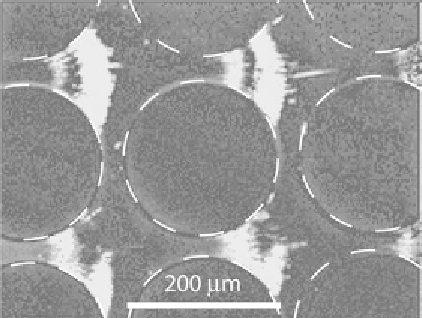Biomedical Engineering Reference
In-Depth Information
Figure 10.14
Electrodeless DEP of Live/dead bacteria. The posts are made of glass and the electric
field is directed from left to right; Because of their different dielectric characteristics, dead bacteria
are trapped at a different spot close to the constriction itself compared to live bacteria (in a wider
region) (from [45]).
acterize it. Historically, the experiments were performed in the positive regime and
the measurement was a collection rate that implicitly assumes that the rate at which
the particles accumulate in this well is proportional to the force they experience
[33]. Making this measurement at different frequencies gives access to a spectrum
of Re(
f
CM
) and thus to the various parameters it covers via multiparameters fits.
10.2.4.3 Levitation Height
However, it has been recognized more recently that these experiments in the posi-
tive DEP regime were difficult because of the many experimental difficulties caused
by electrohydrodynamic flows (see Section 10.2.6.2). An alternative is to measure
the height at which the DEP force can counterbalance gravity and levitate a particle
in the negative DEP regime [49].
This height is given by equilibrating the DEP force and gravity:
2(
ρ ρ
ε
-
)
g
p
l
2
Re(
f
)
Ñ
E
=
(10.26)
CM
3
l
We can express Ñ
E
² as a function of the height z by using a phenomenological
function q(z) that describes explicitly the dependency of the gradient of
E
² with the
height: Ñ
E
² =
U
²/q(z) where U is the rms value of the applied voltage. The levitation
height h is then given by:
æ
ö
2(
ρ ρ
-
)
g
p
l
-
1
h q
=
(10.27)
ç
÷
2
3 Re(
ε
f U
)
è
ø
l
CM
The function
q
(
z
) can be calibrated by levitating well-characterized particles and
medium.
Rather than static measurements, levitation can be combined with an external
hydrodynamic flow (DEP-FFF) as we will see in Section 10.2.7.1.




